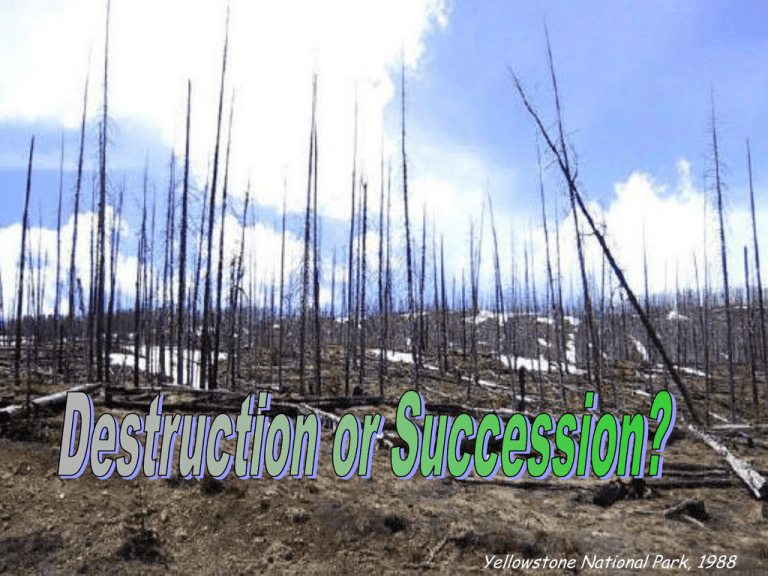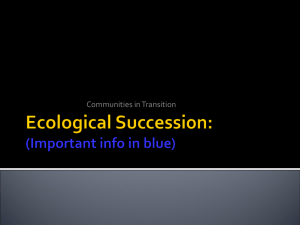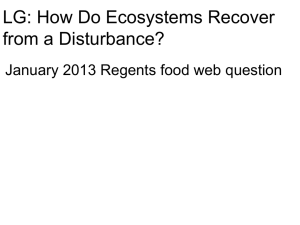Ecological Succession
advertisement

Yellowstone National Park, 1988 Succession is the gradual process of community development. It involves species in one stage being replaced by different species. The time involved in succession is on a scale of tens, hundreds and thousands of years. Abiotic factors such as windstorms, droughts and fire can cause change in a community of plants and animals. Biotic Factors also change communities over time. Insect epidemics can kill trees. Overgrazing can selectively remove species of plants from a forest. Environmental disturbances have natural and man-made causes. This picture was taken in Mesa Verde, Colorado in 2000 This picture was taken after the fire. What plant life will emerge? What plants will succeed after this environmental change? Forest fires are a natural part of the life cycle of the community. After a major change in an environment, grasses, mosses and lichens begin to colonize. It is the first step in the process of succession. 0 5 yrs The first species to colonize or grow in an area are called pioneer species. Only pioneer species are able to grow after a major disturbance in a community due to the lack of soil or nutrients. Examples: lichens and mosses Animals begin to inhabit the area. Usually, insects appear first, then rodents and larger mammals are the last to appear. 0 yrs 5 yrs 15 yrs Opportunistic species take advantage of the work done by the pioneer species. Pioneers modify the environment in such a way that it becomes less suitable for their growth but more suitable for other species. Opportunists eventually replace pioneer species. Examples: grasses & weeds 0 yrs 5 yrs 15 yrs 25 yrs Over time, the decay of pioneer species, grasses and shrubs adds nutrients to the forest floor allowing more complex species to grow. 0 yrs 5 yrs 15 yrs 25 yrs 50-80 yrs The biodiversity of a community continues to increase as it ages. A variety of plants and animals will inhabit the area. 0yrs 5yrs 15yrs 25yrs 50-80 yrs 150+ Succession takes hundreds of years before completion. Species replacement continues until the community is dominated by competitively superior species. Once the community reaches a stable state of maturity it is called a climax community. Timeline 0yrs 5yrs Lichens & Mosses Timeline 0yrs 5yrs 15yrs Grasses & Shrubs Timeline 0yrs 5yrs 15yrs 25yrs Dwarf Trees Timeline 0yrs 5yrs 15yrs 25yrs 50-80yrs Immature Forest Timeline 0yrs 5yrs 15yrs 25yrs 50-80yrs 150+ Mature Forest Timeline 0yrs 5yrs 15yrs 25yrs 50-80yrs 150+ Biodiversity Two Types of Succession Primary succession- a change in an environment where soil never existed before. Examples include recently formed volcanic lava and rock revealed when glaciers melt. Lichens and mosses first grow on the rock then soil forms from decayed mosses. Eventually, shrubs and trees follow. Two Types of Succession Secondary succession also occurs on smaller scales. When Secondary succession- a change in an environment where one giant emergent tree falls, sunlight reaches the forest soil already exists. Examples include areas destroyed by floor. This brings many changes to this section of the forest fire, clear-cutting, or insect epidemics. rainforest. More roads are being built in undeveloped areas. Farmers clear land for crops and easier access to the main road. What type of succession do new roads cause? How would it affect the plants and animals? Deforestation in Madagascar’s rainforest: because of poor soil conditions, savannahs often form once rainforests have been cleared for crops or cattle. What type of succession is pictured here?








